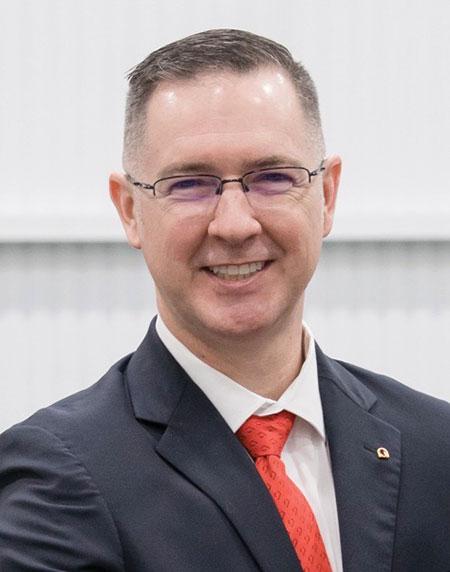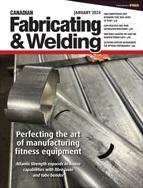Editor
- FMA
- The Fabricator
- FABTECH
- Canadian Metalworking
An even keel for 2024 at AMADA AMERICA
AMADA AMERICA COO Patrick Medlin on lean production and customer sustainability
- By Rob Colman
- February 5, 2024
- Article
- Fabricating

Medlin believes that having production capabilities in North America not only helped AMADA maintain market share but also helped it grow its press brake market share over the past few years. Images: AMADA AMERICA
There has been a resurgence in the encouragement of manufacturing in North America over the past few years. The pandemic and the concomitant supply chain issues that continue to affect some sectors accentuated the need for nearshoring.
A push for increased product built in North America is something that AMADA AMERICA was working on long before these market-driven disruptions. Between its laser and automation production in California and its press brake production in North Carolina, the company has been able to provide a steady stream of product to North American customers for many years.
During a visit to the company’s Brea, Calif. manufacturing facility, Canadian Fabricating & Welding sat down with company COO Patrick Medlin to discuss how AMADA AMERICA has weathered the ups and downs of the past few years and how it plans to keep delivering to customers with a lean mindset in the year ahead.
Canadian Fabricating & Welding: In 2022 into early 2023, we were still talking about supply chain issues and the challenges of sourcing certain parts across the industry. How have things have changed in the past 12 months?
Patrick Medlin: I think the supply chain has certainly improved a great deal. I know it has for components we receive from AMADA JAPAN for building our lasers and press brakes. Many vendors serving our AMS automation that we produce at our Brea facility have also seen a great deal of improvement in supply chain. That was definitely a sticking point for us for all of 2022 and at least the first half of 2023. That flow of components has certainly improved.
CFW: What is the biggest market concern right now?
Medlin: Steel prices are still extremely volatile. In the two previous weeks, hot-rolled coil had jumped up by 14 per cent and cold-rolled jumped up by 17 per cent. Heavy plate seems to be on a little bit of a downward trajectory, but not much. It's still really high compared to pre-pandemic levels. That has certainly precipitated us trying to manage our raw materials inventory and our work-in-process inventory much more tightly. We don't want to go out and make large spot purchases and gamble on what we think the market is going to do, because it's just so unpredictable right now.
CFW: What is your manufacturing strategy to manage this?
Medlin: Right now, we’re managing our work-in-process and our finished machines inventory because we feel it puts us in a much stronger position financially, whereas other companies building at a higher rate will be heavy on inventory and lighter on cash.
At least through the first half of the year we want to work to a just-in-time model, getting products to customers as needed. At that point we’ll reassess and decide whether we want to keep more stock available.

In High Point, N.C., AMADA currently builds the HRB series brakes. There are plans to begin producing some of the company’s new EGB electric press brakes within the year also.
CFW: In Brea, you are currently building your ENSIS and VENTIS laser cutting machines alongside your AMS Automation products. In High Point, N.C., you are currently building the HRB series brakes. Are there any plans to expand what is built in the U.S.?
Medlin: Yes. Some of our higher-kW VENTIS machines are still built in Japan for this market, but those machines will, at some point soon, be manufactured in Brea also.
There are plans to begin producing some of our new EGB electric press brakes in High Point within the year also.
CFW: Are you seeing more demand for electric press brake models?
Medlin: We are. There is definitely more interest from customers trying to reduce their carbon footprints, go greener, and save on energy consumption. To be clear, we have had 40-ton and 60-ton all-electric ball screw-driven press brakes for quite a while. With our new brakes, we are transitioning to offer 80-ton and 130-ton models.
CFW: How has having production here in North America helped you through the past few turbulent years?
Medlin: It certainly helped during the pandemic and the supply chain crisis from a parts standpoint. And it was valuable to be closer to our customers and have more control over the process. I would argue that it not only helped us maintain market share but also helped us grow our press brake market share because of having our factory in North Carolina. We hit the pause button at that facility for about two weeks, but were able to carry on serving our customers, including repairing machines with local parts we had in stock.
CFW: At AMADA AMERICA’s FABTECH Chicago booth, there was a lot of discussion about sustainability and the company’s new electric press brakes. Sustainability is important for laser investments as well—a laser that’s more powerful than a shop needs is wasted money and energy. As exciting as a new 20- or 30-kW machine might be, what advice do you give customers about right-sizing their laser investments?
Medlin: That advice will vary depending on whether we’re speaking to an OEM with a fairly solid product base or a Tier 1 or 2 manufacturer supplying many clients. What we really try to do, if they will allow us, is to employ our VPSS (Virtual Prototype Simulation System) services. With this service, we come in and spend a few days observing, measuring, and collecting data on the type of parts that are flowing through a company’s facility. Then we go back to the office and have consultants and applications engineers analyze that data and then make a recommendation. It really is data driven.
We also want to ascertain not just what the customer is doing now, but we have to find out where they are trying to take the business. If they want to clean-cut 2-in.-thick steel, stainless, or aluminum, then a 30-kW-plus laser probably makes a lot of sense for them. But that’s a niche, not the lion’s share of the market out there.

In Brea, AMADA currently builds its ENSIS and VENTIS laser cutting machines alongside AMS Automation products. Some higher-kW VENTIS machines are still built in Japan for this market, but those machines will, at some point soon, be manufactured in Brea also.
The same thing holds for combination laser and punching machines. We’ll look at a lot of customers’ processes and say, “I know you really want to buy a laser, but what you really need is a punch/laser combo, because when the parts come off it, based on what you’re producing now, it can come off your machine as a finished part instead of having to go through multiple secondary operations.”
With lean manufacturing principles, every time you touch a part and you don’t change the shape of it, you didn’t add any value, just cost. Those are the things we try to educate the customer on and try to help them make the best selection. That’s what we were trying to convey at FABTECH: Throughput is not measured by how many parts a laser can produce or a combi machine can push out, it’s measured by how many parts get loaded onto a truck and invoiced out.
When a customer says they want to be as efficient as they possibly can, we ask what efficiency means to them. Then we try to steer them in the right direction. If you measure efficiency by being able to laser-cut parts in two-thirds the time as your competitor while charging the customer less, that only makes sense if laser cutting and shipping is all you are doing. That’s just the start of the conversation if you are forming and welding also.
The other message we had at FABTECH was about workforce multiplication. With modular automation, the more the human element can be removed from mundane and repetitive processes, the more that talent can be repurposed for more productive use.
Automation is not an all-or-nothing proposition anymore. There are ways to gradually build those capabilities.
CFW: Adopting automation seems essential for any company that wants to stay relevant in the market. What are ways you are encouraging its adoption?
Medlin: I think most customers recognize that today. Ten years ago, even simple automation for blanking or bending was much more expensive. Given the difficulty in finding staff and the drop in those prices, the argument isn’t the same.
That said, we’re working on some projects that, when they roll out this year, will offer some additional options for customers to bridge between purely manual and fully robotic options. The key is helping fabricators achieve greater throughput with fewer people on the floor.
CFW: Looking at the next 12 months, what’s your sense of the market?
Medlin: Based on all the different economic reports, talking with our sales force, and what I’ve seen first-hand, I think it is going to be a pretty flat market for the year. I don’t anticipate any great expansion or contraction. With it being an election year in the U.S., typically everyone tries to avoid any actions that are too extreme.
AMADA AMERICA, www.amada.com/america
About the Author

Rob Colman
1154 Warden Avenue
Toronto, M1R 0A1 Canada
905-235-0471
Robert Colman has worked as a writer and editor for more than 25 years, covering the needs of a variety of trades. He has been dedicated to the metalworking industry for the past 13 years, serving as editor for Metalworking Production & Purchasing (MP&P) and, since January 2016, the editor of Canadian Fabricating & Welding. He graduated with a B.A. degree from McGill University and a Master’s degree from UBC.
subscribe now


Keep up to date with the latest news, events, and technology for all things metal from our pair of monthly magazines written specifically for Canadian manufacturers!
Start Your Free Subscription- Trending Articles
Aluminum MIG welding wire upgraded with a proprietary and patented surface treatment technology

Achieving success with mechanized plasma cutting

Hypertherm Associates partners with Rapyuta Robotics

Brushless copper tubing cutter adjusts to ODs up to 2-1/8 in.

Gema welcomes controller

- Industry Events
MME Winnipeg
- April 30, 2024
- Winnipeg, ON Canada
CTMA Economic Uncertainty: Helping You Navigate Windsor Seminar
- April 30, 2024
- Windsor, ON Canada
CTMA Economic Uncertainty: Helping You Navigate Kitchener Seminar
- May 2, 2024
- Kitchener, ON Canada
Automate 2024
- May 6 - 9, 2024
- Chicago, IL
ANCA Open House
- May 7 - 8, 2024
- Wixom, MI
















